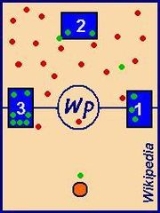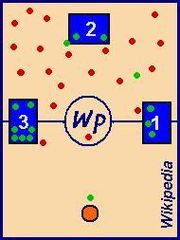
Matball
Encyclopedia
Matball, is an indoor sport
played in schools around the United States
. The main objective of the game is similar to kickball
, but with a few differences. In some areas it is known as Big Base.
, each trying to score by kicking the ball and then running the bases
(represented by mats) successfully. The team with the most runs scored is the declared the winner.

Sport
A Sport is all forms of physical activity which, through casual or organised participation, aim to use, maintain or improve physical fitness and provide entertainment to participants. Sport may be competitive, where a winner or winners can be identified by objective means, and may require a degree...
played in schools around the United States
United States
The United States of America is a federal constitutional republic comprising fifty states and a federal district...
. The main objective of the game is similar to kickball
Kickball
Kickball is a playground game and competitive league game, similar to baseball, invented in the United States in the first half of the 20th Century. Kickball may also be known as kick baseball, base soccer, soccer-base, or soccer-baseball...
, but with a few differences. In some areas it is known as Big Base.
Object
The object of Matball is similar to kickball in which there are two opposing teamsTEAMS
Teams is the plural form of team.TEAMS may also refer to:*TEAMS , a competition sponsored by JETS*TEAMS , an Kenyan initiative to link the country to the rest of the world through a submarine fibre optic cable....
, each trying to score by kicking the ball and then running the bases
Bases
Bases may refer to:*Bases , a military style of dress adopted by the chivalry of the sixteenth century.*Business Association of Stanford Entrepreneurial Students...
(represented by mats) successfully. The team with the most runs scored is the declared the winner.

Rules
- The game is played near identically to kickball in which one team is "batting" (despite the lack of bats) and the other team is "fielding".
- The pitcher is often of the team that is "batting". This enables that the pitches are easy to kick.
- A ball is put in play by kicking the ball into the field of play. That player must then run to first base.
- In matball, there is no limit as to how many players can be on a base at the same time. This allows for players to "load" and run as a pack to decrease the likelihood of getting out. (Alternatively, there may be a limit to the number of players on base, where baserunners arriving at full base must move on to the next base, force someone previously on the base to advance, or be subject to a force out)
- There are no counting of outs in matball. Although being "out" removes you from the inning's play, 3 outs do not retire a whole team from batting. Instead, a team is only retired after depleting their entire lineup. Some schools switch teams after 5 outs.
- Since matball is usually played in school gymnasiums, special rules are often made concerning whether a ball is fair. Traditionally, a ball which hits the ceiling before crossing the halfway mark of the gym is an automatic out. Also, a ball kicked behind Home Plate is foul.
- In matball, a home run often scores a large number of runs. However, since it is usually played indoors, home runs are often designated as hitting a difficult area. In schools with a scoreboard in the gym, hitting that with ball and having it drop without someone catching it will result in a home run. Traditionally, if a player kicks the ball into a basketball hoop opposite Home Plate, it is an automatic home run, regardless of whether or not the ball is caught on the way to the ground.
- Outs in matball occur when: the pop-fly is caught, the ball beats the runner to first base on the initial kick, a runner is touched by the ball while not on base, or runners do not tag-up after a pop-fly is caught.
- Reaching Home Plate does not score a run, and does not give safety from being tagged. In order to score, a player must run past home plate and safely reach first base again.
- In matball, schools often leave doors to the gym open, so that if the ball is kicked out the door, it must be retrieved.
- Matball usually consists of about three innings.
- When a player steps a foot off one mat, that player must advance to the next mat (or in some variations, must advance to all the remaining bases and score, returning to at least first base). This rule may be different in certain schools.
- In some schools, to make scoring more difficult, to score you must touch home plate twice to score. On the runner's first trip on third base he/she would touch home plate and continue to first. The player is not allowed to stay at home plate though. Usually,the first time the runner is going to home, the runner has to run to first base then go around again to home plate.
- Some schools use four bases in a square or rectangle, rather than the traditional softball diamond, with the kicker standing between the first and last bases.
Alternative rules and options
- The out system in matball can be replaced by the baseball system of three outs.
- Instead of a catch counting as an out, you can instead, count it as a point against the kicking team's score decreasing the score by however many pop-fly catches are made.
- Instead of having home runs, you can instead, give one point to the team and move all on-base players to third base.
- The addition of a foul ball rule is also useful which is normally as such: "If the ball does not travel [X] distance forward it is a foul ball." This eliminates the need for a catcher as well as removes the option of bunting.
- Some schools that have basketball hoops in their gym will award extra points for kicking the ball into a hoop.
- Schools might also implement the rule of "No-catch outs", meaning a ball is not out if it's caught
- Some schools have students run around the bases 3 times and allow only 3 students on a base at once.
- Some schools allow students to run in either direction, clockwise or counter clockwise, however, once a student starts in a specific direction, they must continue in that direction.
- Some schools have students reverse direction after touching home plate. Students must therefore touch all the bases in a counterclockwise and then clockwise direction to score.

